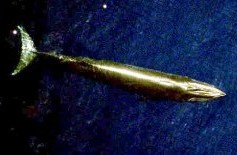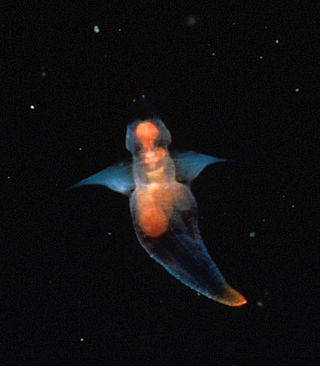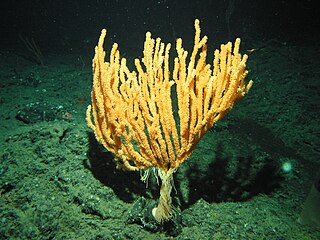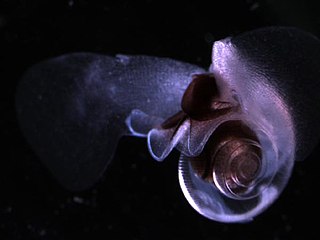
The Caribbean Sea is a sea of the Atlantic Ocean in the tropics of the Western Hemisphere. It is bounded by Mexico and Central America to the west and southwest, to the north by the Greater Antilles starting with Cuba, to the east by the Lesser Antilles, and to the south by the northern coast of South America. The Gulf of Mexico lies to the northwest.

Bryde's whale, or the Bryde's whale complex, putatively comprises three species of rorqual and maybe four. The "complex" means the number and classification remains unclear because of a lack of definitive information and research. The common Bryde's whale is a larger form that occurs worldwide in warm temperate and tropical waters, and the Sittang or Eden's whale is a smaller form that may be restricted to the Indo-Pacific. Also, a smaller, coastal form of B. brydei is found off southern Africa, and perhaps another form in the Indo-Pacific differs in skull morphology, tentatively referred to as the Indo-Pacific Bryde's whale. The recently described Omura's whale, was formerly thought to be a pygmy form of Bryde's, but is now recognized as a distinct species. Rice's whale, which makes its home solely in the Gulf of Mexico, was once considered a distinct population of Bryde's whale, but in 2021 it was described as a separate species.

The tropical bottlenose whale, also known as the Indo-Pacific beaked whale or Longman's beaked whale, was considered to be the world's rarest cetacean until recently, but the spade-toothed whale now holds that position. As of 2010, the species is now known from nearly a dozen strandings and over 65 sightings. This is the only species in the genus Indopacetus.

Cymbuliidae is a family of pelagic sea snails or "sea butterflies", marine gastropod mollusks in the superfamily Cymbulioidea.

The Clionidae are a family of sea angels, which are a group of pelagic marine gastropods.
The Notobranchaeidae, or "naked sea butterflies", are a taxonomic family of floating sea slugs, specifically under the subclass Opistobranchia, also called "sea angels".

The Caribbean monk seal, also known as the West Indian seal or sea wolf, was a species of seal native to the Caribbean which is now believed to be extinct. The main predators of Caribbean monk seals were sharks and humans. Overhunting of the seals for oil and overfishing of their food sources are the established reasons for the seals' extinction.

The National Marine Fisheries Service (NMFS), informally known as NOAA Fisheries, is a United States federal agency within the U.S. Department of Commerce's National Oceanic and Atmospheric Administration (NOAA) that is responsible for the stewardship of U.S. national marine resources. It conserves and manages fisheries to promote sustainability and prevent lost economic potential associated with overfishing, declining species, and degraded habitats.

The green sea turtle, also known as the green turtle, black (sea) turtle or Pacific green turtle, is a species of large sea turtle of the family Cheloniidae. It is the only species in the genus Chelonia. Its range extends throughout tropical and subtropical seas around the world, with two distinct populations in the Atlantic and Pacific Oceans, but it is also found in the Indian Ocean. The common name refers to the usually green fat found beneath its carapace, not to the color of its carapace, which is olive to black.
Peraclidae is a family of pelagic sea snails or "sea butterflies", marine gastropod mollusks in the superfamily Cymbulioidea.

Caranx lugubris, the black jack, black trevally, black kingfish, coal fish or black ulua, is a species of large ocean fish in the jack family Carangidae. The species has a circumtropical distribution, found in oceanic, offshore waters of the tropical zones of the Pacific, Atlantic and Indian Oceans. The species is particularly prevalent around offshore islands such as the Caribbean islands in the Atlantic, Hawaii and French Polynesia in the Pacific and the Seychelles and Maldives in the Indian Ocean. Black jack are rare in shallow waters, preferring deep reefs, ledges and seamounts in clear waters. The species is easily distinguished by its black to grey fins and jet black scutes, with the head having a steep profile near the snout. The largest recorded length is 1 m and weight of 17.9 kg. The black jack lives either individually or in small schools, and is known to school with other species. It is a predatory fish, taking a variety of fish, crustaceans and molluscs as prey. Sexual maturity is reached at 34.6 cm in females and 38.2 cm in males, with spawning taking place between February and September in the Caribbean. The early life history of the species is very poorly understood. Black jack are of high importance to many island fisheries, but are rarely encountered in most continental fisheries. The species has a reputation as a gamefish, and is variably considered a terrible or excellent food fish, although several cases of ciguatera poisoning have been attributed to the species. The species was initially named Caranx ascensionis by Georges Cuvier, however several issues with the use of this name have seen Felipe Poey's name Caranx lugubris become the valid scientific name.

The round scad is a species of fish in the Carangidae. It was described in 1829 by the French naturalist and zoologist, Georges Cuvier. Although the round scad is considered a good food fish, it is mostly caught for use as bait.

Bamboo coral, family Isididae, is a family of mostly deep-sea coral of the phylum Cnidaria. It is a commonly recognized inhabitant of the deep sea, due to the clearly articulated skeletons of the species. Deep water coral species such as this are especially affected by the practice of bottom trawling. These organisms may be an important environmental indicator in the study of long term climate change, as some specimens of bamboo coral have been discovered that are 4,000 years old.

Orania corallina is a species of sea snail, a marine gastropod mollusk in the family Muricidae, the murex snails or rock snails.

Cavolinia tridentata is a species of sea butterflies, floating and swimming sea snails or sea slugs, pelagic marine gastropod molluscs in the family Cavoliniidae. It is a common species and is wide spread, being found in European waters, the Atlantic Ocean, the Caribbean Sea, the Gulf of Mexico, the Indian Ocean and in the Pacific Ocean. It lives in the photic zone of the ocean between 0 to 30m in depth.

Limacina helicina is a species of small swimming planktonic sea snail in the family Limacinidae, which belong to the group commonly known as sea butterflies (Thecosomata).

Clio pyramidata is a species of sea butterfly, a floating and swimming sea snail, a pelagic marine gastropod mollusk in the family Cliidae.

Geograpsus lividus is a species of crab in the family Grapsidae. Little research has been conducted on this species. It was originally classified as belonging to the genus Grapsus; however, this name is no longer used.
Cetaceans form an infra-order of marine mammals. In 2020, approximately 86 species of cetaceans had been identified worldwide. Among these species, at least 35 have been sighted in the wider Caribbean region with very widespread distribution and density variations between areas. Caribbean waters are a preferred breeding site for several species of mysticeti, who live further north the rest of the year. The tucuxi and the boto live at the southern periphery of the Caribbean region in the freshwaters of the Amazon river and surrounding drainage basins.

The white-spotted lantern fish, also called Rafinesque's lanternfish, is a species of fish in the family Myctophidae.

















